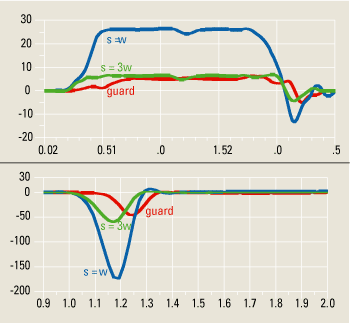
What is the true value of a guard trace?
Your board is finally back from the fabricator. You power it on for the first time and find your sensitive LVDS line has 30 mV too much noise, and it's coming from a CMOS level control line running at 3.3V. The noise is only 1% of the control line voltage, but almost 10% of the LVDS signal. What do you do? How do you reduce the coupled noise between the two lines?
In the last design review, someone said that when he had a noise problem, he fixed it with a guard trace and swears by them now. Should you add a guard trace between the LVDS line and control line?
A guard trace is just another signal line, routing between an aggressor and a victim line. Its ends are often terminated with 50 ohms, shorted or even just left floating. The idea is that the extra line "guards" the victim line shielding the potential noise.
In fact, if you measure the noise on the victim line, it will be dramatically reduced, by more than a factor of 5, with the addition of a guard trace. But the reason behind this effect might surprise you.
In a microstrip geometry, there will be both near end noise and far end noise between two adjacent co-parallel lines. About the only thing the near end noise depends on is the trace-to-trace spacing. If the coupled length is longer than 1 inch for a 300-psec rise time signal, changing the coupled length won't affect the near end noise.
Far end noise is less affected by spacing. However, increasing the rise time (rarely an option) or decreasing the co-parallel length will decrease the far end noise. Of course, the most important way of reducing, and virtually eliminating far end noise, is to route the traces in a stripline geometry rather than a microstrip.
What's the impact on the near and far end noise from using a guard trace?
To fit a guard trace between the two lines requires increasing the spacing to three times the line width. This will allow inserting a trace between them with a space equal to the line width on either side.
We can evaluate this problem by plugging the numbers in by calculation, using a variety of 2D field solvers (such as Polar Instruments SI9000) or by measurement of specially fabricated test vehicles.

FIGURE 1. Top: Measured near end crosstalk in quiet line with 1V signal in aggressor. Bottom: Far end noise in quiet line with a 1V, 100-psec rise time signal in aggressor and 6 inch coupled length. There is virtually no difference between increasing the spacing between traces and adding a guard trace.
|
In this example, we'll look at measurements on microstrip test lines using an Agilent E5230A VNA to take the measurements and Agilent's ADS software to convert the frequency domain measurements into the time domain. Here, an effective 1V signal with a 100-psec 10-90% rise time signal is launched into the aggressor line. There are three different configurations in which the near and far end noise on the victim line is measured: 1) spacing equal to the line width, 2) increasing the spacing to three times the line width, and 3) increasing the spacing to three times the line width and adding a guard trace. In this example, the guard trace is terminated with 50 ohms on each end.
From the measurements, you can see that when the traces are close together it can create create a problematic NEXT of 2.5% and a FEXT of 15%. Just by moving the traces farther apart to a spacing equal to three times the line width, the near end noise is reduced to 0.6% and the FEXT is reduced to 5.5%.
By adding the extra guard trace between the two lines, and terminating its ends, there is a slightly further reduction in the near and far end noise, but it is hardly noticeable.
Therefore, for near end noise levels at the 0.5% (-45 dB) level, guard traces are irrelevant. Just increasing the spacing to three times the line width does all the work. Adding the guard trace provides no added value. If you need lower far end noise than 5%, you can decrease the coupled length, increase the rise time or route the lines in buried traces.
But when high isolation is needed, as in mixed signal applications where -100 dB isolation is important, a guard trace, between stripline traces and with ground vias stitched up and down its length, is essential. PCD&M
Dr. Eric Bogatin is president of Bogatin Enterprises. Many of his papers are available on his Web site, www.BeTheSignal.com. Send your signal integrity technical questions to This email address is being protected from spambots. You need JavaScript enabled to view it..













